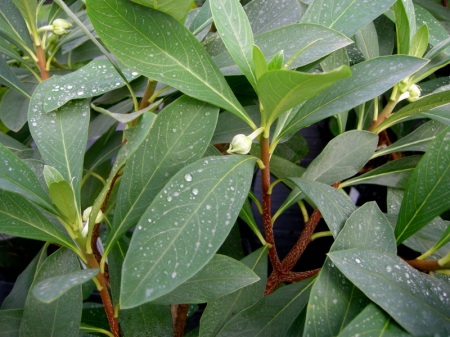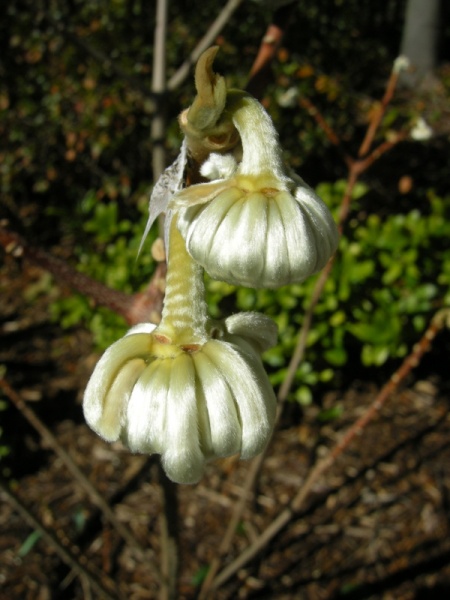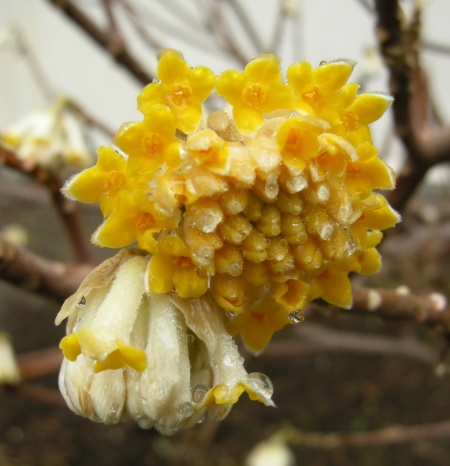Nursery Happenings: Carolyn’s Shade Gardens is a retail nursery located in Bryn Mawr, PA, specializing in showy, colorful, and unusual plants for shade. The only plants that we ship are snowdrops and miniature hostas. For catalogues and announcements of events, please send your full name, location, and phone number (for back up use only) to carolyn@carolynsshadegardens.com. Click here to get to the home page of our website for catalogues and information about our nursery and to subscribe to our blog.
 ‘Long Island Pink’ fall-blooming hardy camellia
‘Long Island Pink’ fall-blooming hardy camellia
As my garden begins to quiet down in the second half of fall, two of my favorite plants come into their full glory. One is fall-blooming hardy camellias, and the other is fall-blooming snowdrops. Both are quite rare, at least in the U.S., but both are quite easy to grow and look wonderful together. And the key to my appreciation of them is that late fall, November and December, is their main season. When other plants are succumbing to frost, camellias and snowdrops begin their show with a fresh and pristine look.
.
 This fall-blooming form of the giant snowdrop selected at Carolyn’s Shade Gardens began flowering on November 1 this year and will be offered in the 2014 Snowdrop Catalogue. Technically it is called Galanthus elwesii var. monstictus Hiemalis Group CSG-01, what a mouthful.
This fall-blooming form of the giant snowdrop selected at Carolyn’s Shade Gardens began flowering on November 1 this year and will be offered in the 2014 Snowdrop Catalogue. Technically it is called Galanthus elwesii var. monstictus Hiemalis Group CSG-01, what a mouthful.
.
 Another shot of my fall-blooming snowdrops showing how they are nestled in among evergreen hellebores and Japanese holly ferns to highlight the pure white flowers.
Another shot of my fall-blooming snowdrops showing how they are nestled in among evergreen hellebores and Japanese holly ferns to highlight the pure white flowers.
I readily admit that I am a snowdrop addict—a galanthophile. And I can even understand how some gardeners fail to get excited about these little white flowers in the spring. However, in November and December when even the hardy cylcamen are done, snowdrops are so bright and cheerful that the winter doldrums disappear the minute I see them. You can even have flowers beginning in mid-October by planting the earliest blooming species Galanthus reginae-olgae. For more on fall-blooming snowdrops, click here.
.
 Another fall-blooming giant snowdrop selected here at Carolyn’s Shade Gardens for it’s early November bloom time and green-tipped outer segments. It received high praise recently when I posted photos on the Scottish Rock Garden Club Galanthus Forum, even the UK galanthophiles with access to hundreds of cultivars were impressed. Hopefully it will multiply quickly and someday I can offer it for sale.
Another fall-blooming giant snowdrop selected here at Carolyn’s Shade Gardens for it’s early November bloom time and green-tipped outer segments. It received high praise recently when I posted photos on the Scottish Rock Garden Club Galanthus Forum, even the UK galanthophiles with access to hundreds of cultivars were impressed. Hopefully it will multiply quickly and someday I can offer it for sale.
I am working on the 2014 Snowdrop Catalogue right now and will have it posted on the website before January 1. There are a lot of exciting cultivars available for 2014, but unfortunately they are in very short supply so if you are interested, order early. I have written quite a few blog posts and articles about snowdrops. You can find them all compiled in the post New Feature Article on Snowdrops by clicking here.
.
 ‘Winter’s Snowman’ fall-blooming camellia has gorgeous, shiny, dark evergreen leaves.
‘Winter’s Snowman’ fall-blooming camellia has gorgeous, shiny, dark evergreen leaves.
.
 ‘Winter’s Snowman’ produces two types of flowers on the same plant: the anemone-form flowers on the right and the more open semi-double flowers on the left.
‘Winter’s Snowman’ produces two types of flowers on the same plant: the anemone-form flowers on the right and the more open semi-double flowers on the left.
Like the snowdrops above, fall-blooming camellias are outstanding in November and December when their large and colorful flowers are shown off to perfection by their shiny evergreen leaves. However, they bring even more to the garden because unlike the ephemeral snowdrops, camellias are shrubs that provide the beauty of their evergreen leaves and lovely habit year round.
.
 ‘Nokoriko’ is new to my garden this year, and I love its unusual flower color. Although it is said to be hardy in zone 6, it is a selection from the species Camellia sasanqua, which is not always hardy in our area. Only time will tell.
‘Nokoriko’ is new to my garden this year, and I love its unusual flower color. Although it is said to be hardy in zone 6, it is a selection from the species Camellia sasanqua, which is not always hardy in our area. Only time will tell.
.
I have written a lot about fall-blooming camellias and featured photos of dozens of plants that are hardy in zones 6 and 7. All my articles are compiled in the blog post New York Times Photos where I provided a link to my camellia photos that appeared in that newspaper. To see those photos and read more about camellias, click here. If you are looking for information about or photos of a particular hardy camellia cultivar, type the name into the Search My Website area on the sidebar of my home page (if the sidebar is not on the right, click here).
.
 This photo of ‘Arctic Snow’ gives an idea of how many buds each camellia can produce.
This photo of ‘Arctic Snow’ gives an idea of how many buds each camellia can produce.
.
The one drawback to fall-blooming camellias is that if we have unseasonably cold weather, below 25 degrees F (-3.8 C) or so, any open flowers can be frozen and ruined. This happened this year during the last week of November when the temperature dropped to an official 21 degrees F (-6 C) but was actually 18 degrees in my garden and as low as 12 degrees elsewhere. However, the unopened buds on my plants didn’t freeze, and the flowers continued to open. We are now experiencing another bout of colder than normal weather, and I am not sure the buds will make it through unscathed this time.
.
.
 A close up of ‘Long Island Pink’ and its beautiful leaves.
A close up of ‘Long Island Pink’ and its beautiful leaves.
.
Usually I visit other gardens to show you camellias. However, this year I am highlighting the cultivars that I grow myself. Enjoy the photos and keep warm during the extra chilly weather we are experiencing.
.
 The oldest camellia in my garden is ‘Lu Shan Snow’, a Camellia oleifera cultivar and the hardy camellia used by Dr. Ackerman at the US National Arboretum to develop many modern hardy camellia cultivars.
The oldest camellia in my garden is ‘Lu Shan Snow’, a Camellia oleifera cultivar and the hardy camellia used by Dr. Ackerman at the US National Arboretum to develop many modern hardy camellia cultivars.
.
.
 ‘Winter’s Joy’ is one of my favorites because it produces so many buds and flowers.
‘Winter’s Joy’ is one of my favorites because it produces so many buds and flowers.
.
.
.
.
Carolyn
.
Carolyn’s Shade Gardens is a local retail nursery in Bryn Mawr, Pennsylvania, U.S., zone 6b. The only plants that we mail order are snowdrops and miniature hostas and only within the US.
If you are within visiting distance and would like to receive catalogues and information about customer events, please send your full name and phone number to carolynsshadegardens@verizon.net. Subscribing to my blog does not sign you up to receive this information.
Facebook: Carolyn’s Shade Gardens has a Facebook Page where I post single photos, garden tips, and other information that doesn’t fit into a blog post. You can look at my Facebook page here or click the Like button on my right sidebar here.
Notes: Every word that appears in orange on my blog is a link that you can click for more information. If you want to return to my blog’s homepage to access the sidebar information (catalogues, previous articles, etc.) or to subscribe to my blog, just click here.






























































